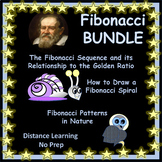Math Lab Fibonacci Sequence Patterns in Nature
- PDF
Also included in
- Welcome to the world of FIBONACCI! The following three labs are presented in an investigative manner, intended to provoke thought among the students and to guide them into an outstanding learning experience as they enter the fascinating world of The Fibonacci Sequence. Each lab addresses the FibonacPrice $11.03Original Price $12.25Save $1.22
Description
Welcome to Kindly Pass The Math!
The following lab is intended to introduce students to The Fibonacci Sequence for the first time.
* The lab is presented in an investigative manner, provoking thought among the students and guiding them into a great learning experience as they initially enter the world of The Fibonacci's Sequence.
* Students find the lab to be as enjoyable as it is a great learning experience.
* Students begin the lab by defining five pertinent terms to the lab investigation.
* The lab continues with examples of the Fibonacci Sequence in nature and a brief introduction to Leonardo Fibonacci, originator of this interesting sequence.
* Students are encouraged to study the sequence to discover the pattern within.
* Through their individual observations, students conclude and explain how consecutive Fibonacci numbers are determined.
* Once students realize the pattern to the sequence, they determine the next consecutive number in the sequence.
* Students write ratios from the Fibonacci Sequence.
* Students convert rations to decimals to compare to the Golden Ratio.
* Students move forward with the lab to support the validity as to whether or not the consecutive numbers in Fibonacci's Sequence approach the Golden Ratio.
* Students research independently through magazines and/or the internet for examples of the Fibonacci Sequence in nature for examples of the Fibonacci numbers between 1 and 21.
* Students conclude the lesson with reflections regarding their lab work in a brief paragraph.
* Finally, students assemble all of their research into a portfolio with the provided cover sheet placed on top.
* This lab is non-stressful to students and provides a great deal of constructive learning.
* The lab is aligned with CC Standards.
* Please enjoy!






